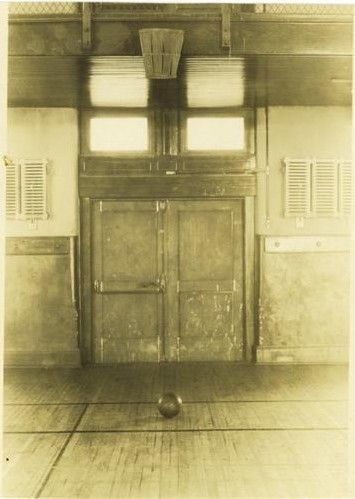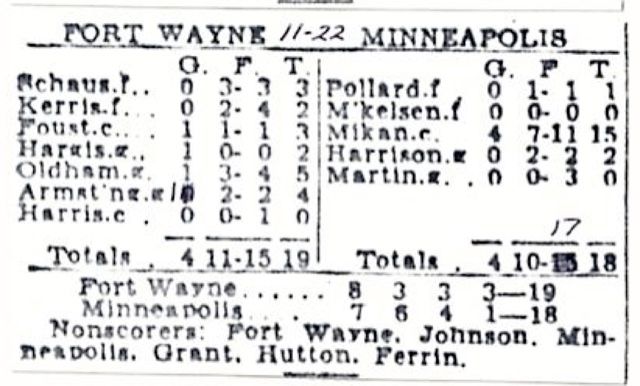Playlist: O'Dark 30 episode 182 (4-26)
Compiled By: KUT

KUT's O’Dark 30 features the very best from the world of independent radio that we can find here on PRX and elsewhere. Sunday nights at 10 on Austin's KUT 90.5 we present 3 hours of a bit of everything from the big wide world of independent radio production.
Episode 182 (4-26) includes 99% Invisible #77- Game Changer...Invisible Ink: For Love...Staying in the Driver's Seat...KUT's Views and Brews Remix: Dueling Organs--the Hammond B-3...Stories from the Heart of the Land I - Portraits in Landscapes...KUT's Liner Notes: Clifford Brown
99% Invisible #77- Game Changer
From Roman Mars | Part of the 99% Invisible (Director's Cut) series | 11:46
The two tweaks to basketball that made it the sports juggernaut it is today.
- Playing
- 99% Invisible #77- Game Changer
- From
- Roman Mars



60 shots per game x 2 teams = 120 total shots per game
One game = 48 minutes = 2880 seconds
2880 seconds per game / 120 shots
24 seconds per shot

Staying in the Driver's Seat
From Sean Rasmussen | Part of the Radio Docs series | 11:46
Will Ted, an 82-year-old man keep his license -- or will be be stuck in his suburban home with nothing to do and nowhere to go? The subject is also the producer's father -- adding a personal touch, and a bittersweet ending.
- Playing
- Staying in the Driver's Seat
- From
- Sean Rasmussen
 This doc follows Ted, an 82-year-old man (and the producer's father) as he tries to renew his license. He's been driving for 66 years and the automobile is central to his lifestyle. He'll be isolated, and trapped in his suburban home without his car. Will he pass the driver's tests? He does, but shortly after has a stroke which takes him off the road for good.
This doc follows Ted, an 82-year-old man (and the producer's father) as he tries to renew his license. He's been driving for 66 years and the automobile is central to his lifestyle. He'll be isolated, and trapped in his suburban home without his car. Will he pass the driver's tests? He does, but shortly after has a stroke which takes him off the road for good.
Ted's not alone -- pretty soon seniors will be 40% of the population. What will these millions do when they can't drive? Our cities aren't set up properly for them.
Ted tells stories of the old-days -- his first car was a Model-T. I contextualize Ted's plight with the larger issue of Elderly mobility. Hear from Gil Penelosa, executive director of 8-80 Cities, a non-profit organization that promotes pedestrian friendly cities and mobility rights for the young, old and poor.
Stories from the Heart of the Land I - Portraits in Landscapes
From Atlantic Public Media | Part of the Stories from the Heart of the Land series | 55:30
Hour-long programs about the intersection of people and the natural world
 You may have noticed that every time you print from your computer, you are faced with a choice: Portrait or Landscape. That can represent a way of looking at the world. One or the other: The head and shoulders of the human form vs. the broad spread of the world we occupy. Or maybe not. Maybe we actually find ourselves, each of us, as portraits within landscapes.
Pieces by Elizabeth Arnold, Jonathan Goldstein, The Kitchen Sisters (Davia Nelson and Nikki Silva), Chris Brookes, Kelly McEvers, Jesikah Maria Ross
1. Out in the Great Bear Rainforest, Elizabeth Arnold discovers that, though she may be ready for the "Great", and for the "Rainforest", she is not so ready for the "Bear."
2. Armed only with a tent, a pack of hot dogs, and a twelve-year old, Jonathan Goldstein confronts his fear of the woods.
3. The Kitchen Sisters' portrait of activist Mark DuBois and his dramatic effort to save a wild river in the west.
4. What is it like to be exiled from a landscape that you can see from your window? When his legs fail him, Chris Brookes finds out.
5. The story of one man's prairie, and his work to let it flourish, even after he dies. Kelly McEvers visits Bob's Prairie in Illinois.
6. Through every season, 97-year-old rancher Attilio Genasci tends to his cattle and his alpine valley in California. A portrait of a man in his landscape by Jesikah Maria Ross.
Original Music for the series was composed and performed by Bill Frisell
NB: ALL PROMOS INTERCHANGEABLE (even those with titles) you can pick and choose. :15 promos need "...Join host Jay Allison for Stories from the heart of the Land" tag.
Funding: Supported by The Nature Conservancy and Visa.
Contact: Deborah Blakeley - blakeley@pclink.com
612-377-1207
You may have noticed that every time you print from your computer, you are faced with a choice: Portrait or Landscape. That can represent a way of looking at the world. One or the other: The head and shoulders of the human form vs. the broad spread of the world we occupy. Or maybe not. Maybe we actually find ourselves, each of us, as portraits within landscapes.
Pieces by Elizabeth Arnold, Jonathan Goldstein, The Kitchen Sisters (Davia Nelson and Nikki Silva), Chris Brookes, Kelly McEvers, Jesikah Maria Ross
1. Out in the Great Bear Rainforest, Elizabeth Arnold discovers that, though she may be ready for the "Great", and for the "Rainforest", she is not so ready for the "Bear."
2. Armed only with a tent, a pack of hot dogs, and a twelve-year old, Jonathan Goldstein confronts his fear of the woods.
3. The Kitchen Sisters' portrait of activist Mark DuBois and his dramatic effort to save a wild river in the west.
4. What is it like to be exiled from a landscape that you can see from your window? When his legs fail him, Chris Brookes finds out.
5. The story of one man's prairie, and his work to let it flourish, even after he dies. Kelly McEvers visits Bob's Prairie in Illinois.
6. Through every season, 97-year-old rancher Attilio Genasci tends to his cattle and his alpine valley in California. A portrait of a man in his landscape by Jesikah Maria Ross.
Original Music for the series was composed and performed by Bill Frisell
NB: ALL PROMOS INTERCHANGEABLE (even those with titles) you can pick and choose. :15 promos need "...Join host Jay Allison for Stories from the heart of the Land" tag.
Funding: Supported by The Nature Conservancy and Visa.
Contact: Deborah Blakeley - blakeley@pclink.com
612-377-1207
Clifford Brown
From KUT | Part of the KUTX Liner Notes series | 02:35
Jazz trumpeter Clifford Brown is known for his precise and captivatingly smooth technique yet his life was tragically cut short in a car accident when he was only 25.
- Playing
- Clifford Brown
- From
- KUT
 Brown recorded most notably with drummer Max Roach and saxophonist Sonny Rollins, and his compositions Joy Spring and Daahoud are jazz standards to this day. His lasting impact on the jazz cannon is profound. In this short feature Rabbi Neil Blumofe discusses what Brown's legacy teaches us about the strength and importance of following ones own path in spite of contradictory expectations.
Brown recorded most notably with drummer Max Roach and saxophonist Sonny Rollins, and his compositions Joy Spring and Daahoud are jazz standards to this day. His lasting impact on the jazz cannon is profound. In this short feature Rabbi Neil Blumofe discusses what Brown's legacy teaches us about the strength and importance of following ones own path in spite of contradictory expectations.